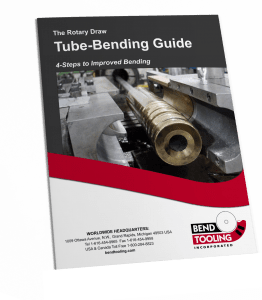Whether the times are lean or fat, cost-effective tube bending always makes sense. Just like any other manufacturing operation, keeping rotary-draw tube bending profitable means process control. That means: (1) Bringing under control all of the elements of the bending process to eliminate unpredictable results, (2) optimizing these elements for increased productivity within the bounds of quality requirements, and (3) translating this efficiency into profits.
Rotary-draw tube bending is a tool-intensive metal-forming operation. The mandrel and wiper are critical to supporting the tube at the point of bend to produce consistently high-quality results. The objective of this support is to plastically deform the tube along the arc of the bend with minimal distortion of its cross-section. Therefore, the mandrel and wiper are primary elements in the rotary-draw tube bending operation. This article covers an objective method of selecting the right mandrel and wiper for this task.
For many years, tube bending engineers have relied upon tables to specify the mandrel and wiper needed for a job. These tables in the form of the familiar mandrel-wiper chart (see here) remain a convenient means of boiling down into standard recommendations the mathematical formulas and rules of thumb that go into this specification.
The typical mandrel-wiper chart displays the recommendations by wall factor vs. “D” of bend. The wall factor is the tube outside diameter divided by the wall thickness. The “D” of bend is the centerline radius of the bend divided by the tube outside diameter. Where these two measures intersect on the chart is the mandrel and wiper recommended for that tube bend.
On most mandrel-wiper charts this recommendation indicates: (1) Whether or not a mandrel is required for the tube bend; (2) if so, what the pitch and number of balls should be; and (3) whether or not a wiper is required. Additional is sometimes also available. The chart in Figure 1 also indicates whether standard tooling or high-pressure tooling is needed to make the tube bend.
For example, the tube bend is 2” TOD x .065” WT x 4” CLR. The wall factor = 2” TOD / .065” WT = 30.8. The “D” of bend = 4” CLR / 2” TOD = 2.0. Using the mandrel-wiper chart here find the row with the largest wall factor equal to or less than 30.8. That is Row “30”. Similarly find the column with the largest “D” of bend equal to or less than 2.0. That is Column “2”. Find the recommendation at the intersection of Row “30” and Column “2”. The value there is “R2W”. (See Figure 2.) The “R2” means that a regular-pitch 2-ball mandrel is required. The “W” means that a wiper is also required. The “W” has a further meaning: Standard tooling, as opposed to high-pressure tooling, is sufficient to make the tube bend. The distinction between standard and high-pressure tooling is explained below.
ZONES OF DIFFICULTY
It can be readily observed from an examination of the mandrel-wiper chart in Figure 1 that the greater the wall factor, the more difficult it is to make the tube bend. Conversely, the greater the “D” of bend, the less difficult it is. Therefore, the most difficult bends are at the lower left-hand corner of the chart, and the least difficult bend are at the upper right-hand corner. Accordingly, the tooling recommendations sort themselves out into for four zones of difficulty.
The first zone, emanating from the upper right-hand corner, includes those bends that require no mandrel and no wiper. This is because either the wall thickness relative to the tube diameter is heavy enough or the centerline radius relative to the tube diameter is large enough so that the tube material has sufficient strength to support itself at the point of bend.
The second zone includes those bends that require a standard mandrel but no wiper. The third zone requires a standard mandrel and a standard wiper. Finally, the fourth zone, emanating from the lower left-hand corner, includes the bends that are the most difficult because of very thin walls or very tight bend radiuses. These bends require both a high-pressure mandrel and a high-pressure wiper for full control of the tube material at the point of bend.
With the advent of inserted mandrel and wiper tooling, it has become important to distinguish which tube bends are best suited to their use and which ones require their non-inserted counterparts. This divide between inserted (or standard) tooling and non-inserted (or high-pressure) tooling comes when the extremes of thin walls and tight bend radiuses necessitate the application of relatively high radial pressure from the pressure die against close-fitting mandrels and wipers set at zero-rake. Under these circumstances, higher pressure causes the tube material to be marked, distorted, or subject to excessive drag from the parting lines and other features that break the working surfaces of standard tooling – thus, the need for high-pressure tooling that has continuous working surfaces.
Therefore, the second and third zones call for standard mandrels and wipers for the most cost-effective tooling to make these bends, and the fourth zone calls for high-pressure mandrels and wipers. If you are not using a modern mandrel-wiper chart that makes this important distinction between standard and high-pressure tooling, generally a recommendation from an obsolete chart for a close-pitch 5-ball mandrel and above should be interpreted as a call for high-pressure tooling.
ADJUSTING FOR SECONDARY PARAMETERS
As already indicated, the wall factor and the “D” of bend are the primary parameters in selecting the right mandrel and wiper for a tube-bending job. The degree of bend and the tube material are also important. However, the two-axis nature of a mandrel-wiper chart does not allow for a direct input of these secondary parameters. Instead they must be taken in account by making adjustments to the recommendation produced by the intersection of the wall factor and the “D” of bend.
Like the wall factor, the greater the degree of bend the more difficult it is to make. Because degree of bend is a secondary parameter, most mandrel-wiper charts are compiled on the basis of a 180-degree bend. If the degree of bend is under 45 degrees, adjust the “D” of bend one column to the right (i.e., to the next higher “D”) for a suitable recommendation.
Adjustments for tube material can be similarly made. Again most mandrel-wiper charts are predicated on an assumption about material: The tube is a mild steel or other material with similar elasticity and plasticity. This includes all non-stainless steels and most non-ferrous metals. However, some materials are more difficult to bend and require firmer control at the point of bend. To account for this, adjust the “D” of bend one column to the left (i.e., to the next lower “D”) for stainless steel, titanium, copper-nickel, and “T6” aluminum (e.g., 6061-T6) tubing. Adjust two columns to the right for high-nickel stainless steel (e.g., 314 and 329 grades) and nickel alloy (e.g., Inconel) tubing.
CHART LIMITATIONS
All mandrel-wiper charts are limited by the practical range of rotary-draw tube bending. The chart is most expansive in this regard. First, it ranges from a wall factor of zero (i.e., solid rod), for which no mandrel or wiper is required, to “200” (e.g., a 2” TOD x .010” WT), which is very rare. Second, it ranges from a “D” of bend of “3/4”, which is tightest tube bend suitable for rotary-draw tube bending (and then only in limited cases), to “12”, which seldom encountered because roll and press bending are usually more efficient.
Another important limitation is that mandrel-wiper charts are compiled for round tube. It is possible to approximate the mandrel and wiper tooling needed for square, rectangular, oval, and elliptical tube from the chart . Generally, they should be treated like the tougher materials to bend by adjusting the “D” of bend column to the left. However, there is not a rule of thumb because the ratio of the major to minor axis, the corner radius, and the plane of bend (i.e., the “hard” or “easy” way) all must be factored into that adjustment.
Finally, all mandrel-wiper charts are limited by assumptions about the tooling and its set-up. For example, this chart assumes certain best practices like the “forward nose” set-up of a link-type mandrel – as opposed to a cable mandrel, which is often set with the first ball at the line of tangency. It also assumes certain specifications such as a precision nose radius for the mandrel instead of a larger high-production one and a nose diameter that is close-fitting (i.e., ND = TOD – WT x 2.21) rather than loose.
AFFORDABLE TOOLING
This objective method of using a mandrel-wiper chart to select the right mandrel and wiper for a tube-bending job opens the way to cost-effectiveness:
- It specifies what tooling is sufficient to achieve process control. The job is not under-tooled and so not unstable and unpredictable. Nor is the job over-tooled and so more tooling is consumed per bend than is necessary.
- A job under process control reduces the incidence of failure. Failure, often from unbalanced forces being applied to the tube, tooling, or the machine, is expensive. It disrupts the flow of work. It scraps tubing. It shortens tool and machine life.
- Finally, process control increases productivity. Fewer resources are needed in terms of labor, machine time, tooling and supplies, and overhead to get the job done.
Therefore, consult a modern mandrel-wiper chart to put yourself on the path to profitability in your rotary-draw tube-bending operations.

